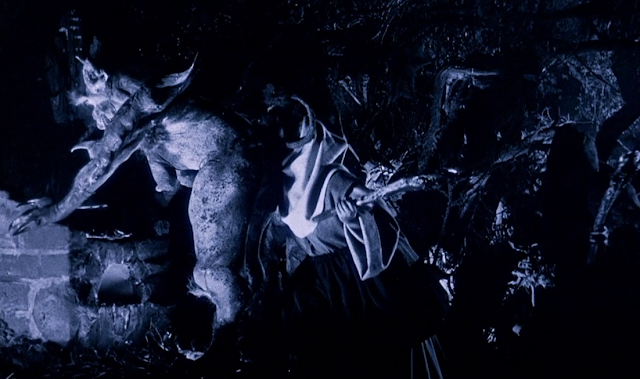 |
| Witches fly over cavorting Devils |
Nearly one century removed from its release, Häxan ("Witch"), alternately referred to in English as "Häxan: Witchcraft Through the Ages", remains a peculiar milestone in the history of occult horror. A lavish production, in fact the most costly Swedish film ever produced at the time, Haxan invokes a carousel of vivid imagery to explore notions of witchcraft in the western world- although, contrary to the English title, the film steadies its focus solely on the medieval period, avoiding explicit reference to the Salem witch trials while seeming to integrate certain details to expand its description of earlier episodes of persecution.
 |
| Witches lining up to plant one on a Devil's bottom |
The presentation unites a documentary style with scenes of dramatic reenactment, proceeding through seven chapters that detail the imagined scenarios of medieval witchcraft, their more mundane counterparts as they may have appeared in actuality, and the persecution and methods of torture to which those deemed witches were subjected. Haxan is nakedly didactic in purpose, embedding its drama within an exploration of pre-modern views of the natural world, seeking to understand medieval prejudice through the lens of contemporary science.
Unfortunately, this desire towards explication resolves in the asinine suggestion that those accused of witchcraft were afflicted with 'hysteria' (a claim more often reserved for their persecutors, although hardly less inapt considering the connotations of the term). While this sort of rationalism is marred by such strains of pop-psychology as were fashionable at the time, the film is nonetheless suffused with sympathy for the suffering of those implicated and contempt for the cruelty masquerading as piety that ruled the day.
But the intellectual content of the work should not distract for long, as we consider certain creative feats that have rarely been matched in the ensuing decades. In terms of mood and direction, art and effect, Haxan is triumphant. The visual aspect of the film is immaculate; every monastic garb and stately cloister, every iniquitous den and withered face is invested with profound texture, and there is a balance between features general and specific that is only enriched by the episodic format. The cellar inhabited by the witch Karna is alarming in the intimacy of its realization, evoking every symbol of the sorcerer's lair, all herbs and cauldron and bleached bone, perhaps the supreme archetype for all that would follow after. But most striking of all are those demonic figures which populate the sabbatic rituals so vividly illustrated in the film's middle portion. |
| A bewitched cat (Left) and the infernal Beleth (Right) |
All of these images are realized with grotesque splendor. The full power of illusion is called upon, including every special effect that had formed in the repertoire of film over the two decades and change prior. Soaring witches and disembodied spirits are portrayed through superimposition, demonic shapes are suggested by silhouette where the plain light of day might have diminished their power, spells exhibit their effect in reverse or stop-motion, and so on. One intention was to establish a filmic language that would stand apart from the melodramas and literary adaptations that were in vogue at the time, and in this striving is concentrated the exuberance of many artists bringing the full force of an infant medium to bear.
Christensen likely did not associate his work with the horror genre in the sense that it is evoked today, but it resides comfortably in the same continuity as tremendous works such as L'inferno (1911), where the primacy of atmosphere and effect evolved naturally from the earliest 'trick' films of George Méliès. Haxan, along with the contemporaneously produced Nosferatu (1922), heralds the flowering of occult horror within the European theatre, propelled by expressionistic impulse and unfettered by nascent ideas concerning propriety and decency in the production of film images.
 |
| Satan (Benjamin Christensen) furiously churning |

No comments:
Post a Comment